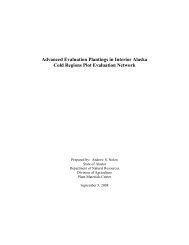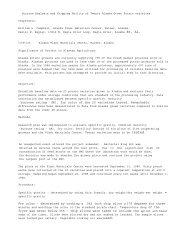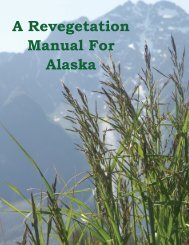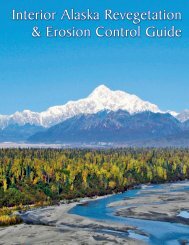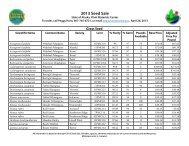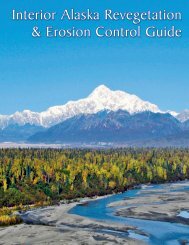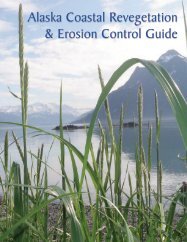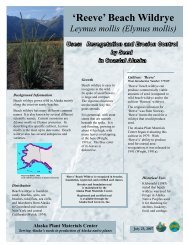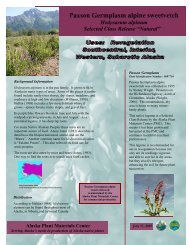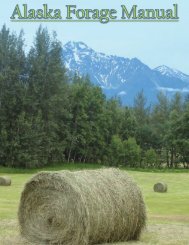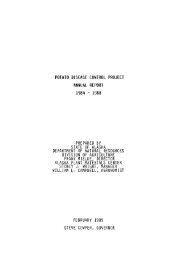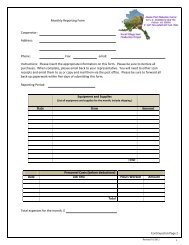Alaska Forage Manual - Alaska Plant Materials Center - State of ...
Alaska Forage Manual - Alaska Plant Materials Center - State of ...
Alaska Forage Manual - Alaska Plant Materials Center - State of ...
You also want an ePaper? Increase the reach of your titles
YUMPU automatically turns print PDFs into web optimized ePapers that Google loves.
Silage Cropping<br />
Haylage<br />
Photos: Casey Dinkel, AK PMC<br />
Silage is stored in an anaerobic environment to promote fermentation.<br />
Typical moisture content ranges from 40% - 60%.<br />
Ensiling is a process that involves taking fairly<br />
wet (moisture level between 40-60%) early growth<br />
green forage and putting it into silos or pits under<br />
airtight, anaerobic conditions. If moisture conditions<br />
get any higher, clostridial bacteria may grow. The<br />
harvested crop must be well chopped and placed in<br />
a pit and packed tightly together, driving out air so<br />
the anaerobic fermentation process can begin. Fermentation<br />
will produce lactic acid, converting the<br />
high moisture forage plants to a stored energy food<br />
source.<br />
Producers may choose to routinely produce<br />
silage, or produce silage only when field drying is<br />
difficult or impossible. A more informative in-depth<br />
article about the ensiling process was written by<br />
the Iowa <strong>State</strong> University - Cooperative Extension<br />
Service, and can be located at the following address:<br />
www.extension.iastate.edu/Publications/PM417H.pdf.<br />
These large hay bales have an average moisture content<br />
between 20% and 40%. These bales are known as haylage or<br />
sometimes called ‘Sweet Hay’.<br />
The ensiling process for haylage follows silage<br />
and only really differs in the lower moisture<br />
content. Crops are ensiled at 20-40% moisture. Slight<br />
variations in moisture percentage may affect the desired<br />
outcome. When moisture content at harvest<br />
time is too low, the crop becomes too dry for harvesting<br />
and storage <strong>of</strong> haylage. At this stage, making<br />
the transition to a hay crop is advised.<br />
Photo: Todd Paris, UAF<br />
Advantages<br />
• Lower chance <strong>of</strong> weather delays and weather<br />
related damage during harvest;<br />
• Lower field, harvest, and storage loss; and<br />
• Provides flexibility and is adapted for many<br />
feeding programs.<br />
Evaluating Silage<br />
Individual round haylage bales stored for future use<br />
Disadvantages<br />
• <strong>Forage</strong> content is high in moisture, resulting in<br />
heavier forage that is difficult to haul;<br />
• Specialized equipment for harvesting, storing,<br />
and feeding may be needed;<br />
• Potential for high losses if silage is not properly<br />
made; and<br />
• Quality decreases rapidly after the pit is opened.<br />
8



